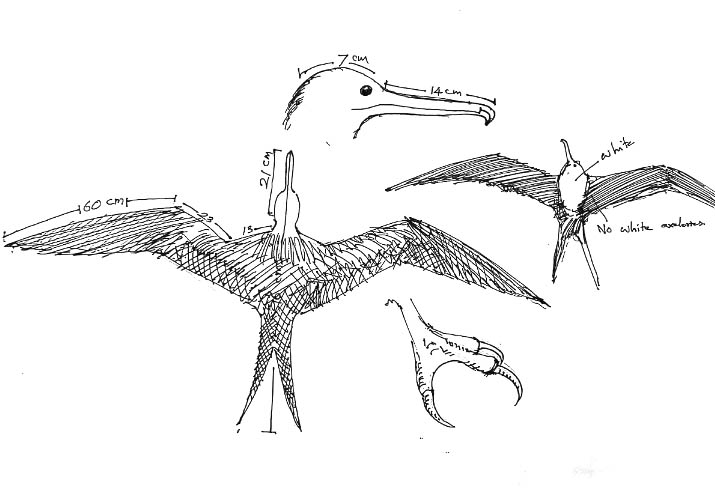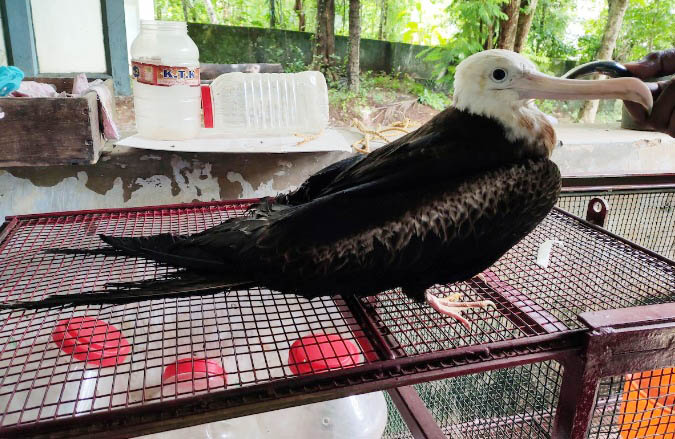A frigatebird was recovered from the Chombala harbour area (11º 39 52N 75º 33 00E) of Kozhikode district on 30 June 2019 by the local fishermen. The bird was in an exhausted condition and had some injuries on the femoral area of right leg. It was handed over to the Kerala Forests and Wildlife Department officials of Kuttiady range. They tried to feed it with marine fish, but it was reluctant to feed. Later, the bird was taken to the Kerala Veterinary and Animal Sciences University, Pookode, Waynad for further care. Unfortunately, the bird died on 5 of July 2019.
The bird was initially identified it as Greater Frigatebird Fregata minor. Later, the experts at Bird Count India and David James, a pelagic bird expert in Australia, with the help of measurements and plumage characters of this specimen confirmed it as Christmas Island Frigatebird Fregata andrewsi.
David James commented:
“The bird is in first cycle plumage. The rufous feathers on the chest are formative plumage acquired in the partial pre-formative (post juvenile) moult, which begins around the time of fledging. The pre-formative moult distorts the shape of the breast band making it harder to use the belly shape for identification, as the moult progresses. The shape of the belly patch is difficult to determine in all the photos. There is a slight nuchal crest. Great and Lesser Frigatebirds never have a nuchal crest. It is a prominent feature of adult Christmas and is present in its first stage Christmas, although less developed. This is probably diagnostic. There are small pure white patches on the scapulars. I have never seen these on any frigatebirds except adult Christmas. They are rare on adults. It seems they may occur on first cycle birds (and probably all other ages) as a rare feature. However, it might be an effect of feather displacement due to handling. The white belly patch extends well behind the base of the legs, which is typical of Christmas in first cycle. The fringes of the alar bar are not especially prominent and there is no scaling on the mantle (correlated features). Some Christmas (probably females) show extremely pale alar bars and extensive pale fringes on the mantle but other do not (probably males). This feature does not eliminate Christmas. Axillary spurs occur in all three Asian species and can be diagnostic. They are variable however. The axillary spur seems to be confined to the body; they certainly do not extend far into the underwing coverts. Short spurs can mean Great or Christmas. Ragged spurs usually mean Christmas. However, the photos do not show this feature clearly, and it is difficult to know how much the feathers are disturbed and out of position. The bill appears to be very long. However, judging such things by eye is ill-advised. The measurement of 14 cm (culmen from feathers, as per photos) is consistent with Great (some populations) and Christmas. In summary, the most important feature appears to be the crest feathers. Without these, I think the identification would be very uncertain.”
Christmas Island Frigatebird (measurements)Storm blown frigatebirds have been reported many times from the Kerala coast during the monsoon months. Most of the records were of Lesser Frigatebird Fregata ariel or Greater Frigatebird (Sashikumar et al., 2011; Rasmussen & Anderton, 2012). A review by Praveen et al. (2013) also ruled out many of the earlier records of Christmas Island Frigatebird from India as non-conclusive. Dipu Karuthedathu (2015) mentioned five sightings from the coastal waters of Peninsular India including a record from Ankola, Maharashtra in July 2014, Uduppi, Karnataka in August 2014, Rameswaram, Tamil Nadu in Aug. 2014 and from Kanyakumari, Tamil Nadu on September 2014 mostly during July end to early September, coinciding with the south-west monsoon.
Christmas Island Frigate Bird is a lesser known frigate bird species listed in the ‘Critically Endangered’ category of the IUCN Redlist. It breeds only in the Christmas Island in the Indian Ocean with an estimated population of around 2400-4800 (Birdlife International, 2019).
References:
BirdLife International (2019) Species factsheet: Fregata andrewsi. Downloaded from http://www.birdlife.org on 05/08/2019.
James, D. J., 2004. Identification of Christmas Island, Great and Lesser Frigatebirds. BirdingASIA 1: 22–38
Karuthedathu, D., James, D., Sasidevan, A., Moghul, M., Parab, P., Davidson, S. S., Manickam, S., Rao, V., & Vineeth M. 2015. A compilation of frigatebird sightings from 2014, including Christmas Island Frigatebird Fregata andrewsi. Indian BIRDS 10 (5): 115–118.
Praveen J., Jayapal, R., & Pittie, A., 2013. Notes on Indian rarities—1: Seabirds. Indian BIRDS 8 (5): 113–125.
Rasmussen, P. C., & Anderton, J. C., 2012. Birds of South Asia: the Ripley guide. 2nd ed. Washington, D.C. and Barcelona: Smithsonian Institution and Lynx Edicions. 2 vols. Pp. 1–378; 1–683.
